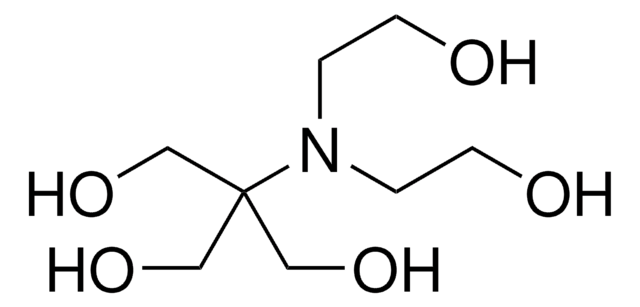34871
1-Propanol
suitable for HPLC, ≥99.9%
Synonym(s):
Propyl alcohol
About This Item
Recommended Products
vapor density
2.1 (vs air)
Quality Level
vapor pressure
10 mmHg ( 147 °C)
14.9 mmHg ( 20 °C)
assay
≥99.9%
form
liquid
autoignition temp.
700 °F
expl. lim.
13.7 %
technique(s)
HPLC: suitable
impurities
≤0.0005% non-volatile matter
≤0.001% free acid (as C2H5COOH)
≤0.05% water (Karl Fischer)
evapn. residue
≤0.005%
transmittance
220 nm, ≥40%
240 nm, ≥85%
275 nm, ≥99%
refractive index
n20/D 1.384 (lit.)
pH
8.5 (20 °C, 200 g/L)
bp
97 °C (lit.)
mp
−127 °C (lit.)
density
0.804 g/mL at 25 °C (lit.)
λ
neat
UV absorption
λ: 220 nm Amax: ≤0.40
λ: 240 nm Amax: ≤0.071
λ: 275 nm Amax: ≤0.0044
SMILES string
CCCO
InChI
1S/C3H8O/c1-2-3-4/h4H,2-3H2,1H3
InChI key
BDERNNFJNOPAEC-UHFFFAOYSA-N
Looking for similar products? Visit Product Comparison Guide
Related Categories
General description
Application
signalword
Danger
hcodes
Hazard Classifications
Eye Dam. 1 - Flam. Liq. 2 - STOT SE 3
target_organs
Central nervous system
Storage Class
3 - Flammable liquids
wgk_germany
WGK 1
flash_point_f
71.6 °F - closed cup
flash_point_c
22 °C - closed cup
Certificates of Analysis (COA)
Search for Certificates of Analysis (COA) by entering the products Lot/Batch Number. Lot and Batch Numbers can be found on a product’s label following the words ‘Lot’ or ‘Batch’.
Already Own This Product?
Find documentation for the products that you have recently purchased in the Document Library.
Customers Also Viewed
Our team of scientists has experience in all areas of research including Life Science, Material Science, Chemical Synthesis, Chromatography, Analytical and many others.
Contact Technical Service









